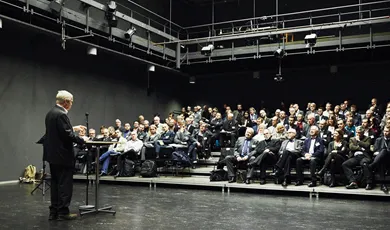What do we know about military organisations? A lot, many would say. However, the social research on the subject has mainly focused on what is considered most typical for military activities, such as formalisation, role-driven behaviour and impersonal relationships. We know less about the inner life of military organisations. This book aims to problematise the simplified and one-dimensional view by examining military professional practices from a cultural perspective.
In the book, the author describes how social structure and material arrangements – from personal equipment to buildings and technical systems – interweave in different ways and how shared ideas and perceptions develop over time and space.
The book has a broad empirical focus, with studies of military professional practices within the army, air force, and navy. An exploratory approach has been chosen because so little is actually known about the large and multifaceted activities that modern defence forces constitute.
Hans Hasselbladh is a professor of business administration, specialising in organisation theory, at Örebro University. He has researched reforms in the public sector, professions, governance and power and has published in, among others, Organization Studies, Organization, Public Administration, Theory & Society, Research in Organizational Sociology and Armed Forces & Society, and authored several books.

The text is taken from Studentlitteratur's website and the book can be ordered there. Here is a link to Studentlitteratur.
Contents
Thanks 9
Reading instructions 11
1. Introduction 13
Military culture and organisation – an introductory description of the study's approach and focus 24
Studying military organisations 32
A theoretical conceptualisation of the military professional practice 40
Presentation of the book's chapters 45
Part I Background and theory
2. The military's institutional roots and material foundations 53
Four configurations 53
Free warriors – an archaic social form and modern ideology 56
The birth and long life of the war machine in new forms 59
The war machine liberated from muscle power 64
The industrialisation and digitalisation of the war machine 68
3. Agency and materiality 73
Technology, material arrangements, and social structure 73
Military materiality 77
Materiality as a theoretical puzzle 81
Materiality and military organisations 88
4. Research on culture in military organisations 93
Why does research on military organisations look the way it does? 93
The group as a focal point for understanding military organisations 95
Research on military culture 101
Culture and organisation in military units 108
5. Studying military organisations as cultures 123
The use of the concept of culture in the study and ethnographic method 123
The social anthropological perspective directed at modern working life 128
On the study's empirical focus, method and implementation 136
Empirically analysing cultural meanings 144
Part II Empirical – overarching themes
6. An institution adrift 157
The contemporary institutional context 157
The late history of the armed forces summarised in two archetypes 159
New direction: an old-new armed forces but not so fast 168
Old furniture and memories from a bygone era 170
“Infanterisation” – a culturally borne standardisation? 175
A symbolically homogenised armed forces moving forward at high speed? 180
7. “That's how it is said” – fragments of an organisational ideology 183
Is it possible to create an organisational culture? 183
The prescribed role as an employee in the armed forces 188
The prescribed officer role 192
The compliant who takes initiative 195
The fixed world 201
8. Style, moods, and different worlds in the armed forces 207
On the inside 207
The great desolation and disciplined bodies in the military space 209
Becoming “military” 212
The common and the distinctive 219
Professional interaction and orientation in different military contexts 222
Part III Empirical – delimited themes
9. Boundaries, distinctions, and fluid categories 239
Everything in its place 239
Civil–military: a constitutive distinction 243
The contamination of the administrative logic in the professional clean room 245
Internal distinctions 248
The presence of the past in the present 252
A fluid existence? 256
10. The material embedding of military practices 259
The elusive self-evidence of materiality 259
Interacting bodies 262
Fluid societies conducting warfare 266
Between the extremes 271
Free from materiality, wedged in materiality, mixed forms of materiality, and serving materiality 281
11. Professional practice and governance in military activity 285
Is it just a matter of obeying orders? 285
The material embedding of governance in military activity 287
Ground combat: integration of vertical and horizontal social structure 290
Everyone must stand up! 296
Between the extremes 300
Vertical and horizontal social structure – fusion, separation and constant balancing 306
12. Conclusion 311
Shared, conflicting and separated meanings 313
The interplay between social structure and professional practice 324
The material anchoring of organising, the meaning of instrumental orientation, and artificial agency 332
References 337
Appendix 355
Appendix 1. Description of the formal structure of the armed forces 355
Appendix 2. Interview guide 357
 Photographer: Joel Thungren, Swedish Armed Forces
Photographer: Joel Thungren, Swedish Armed Forces














